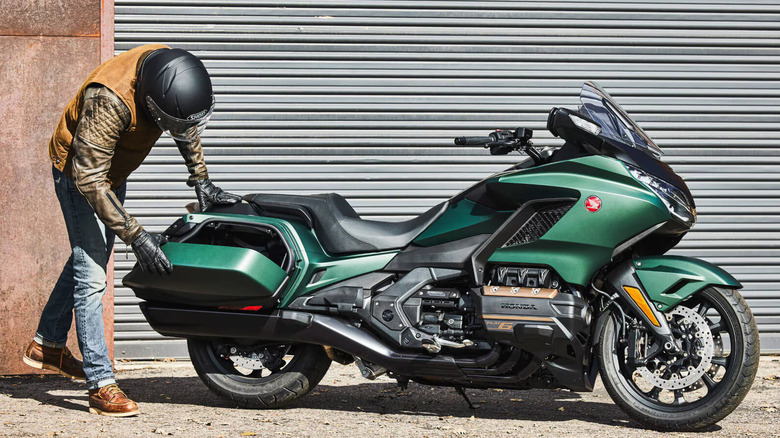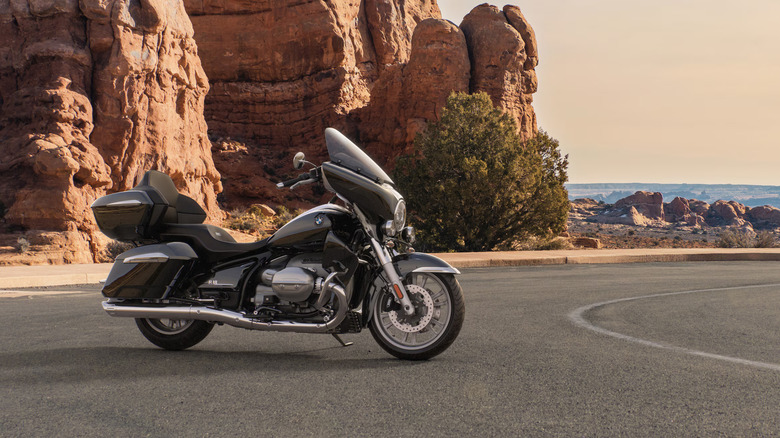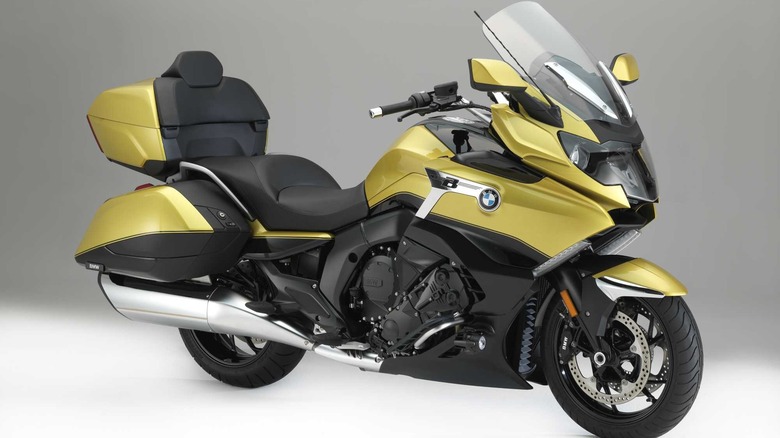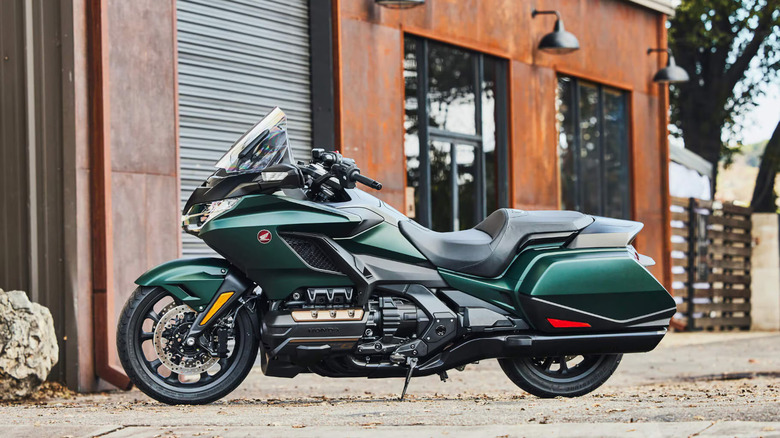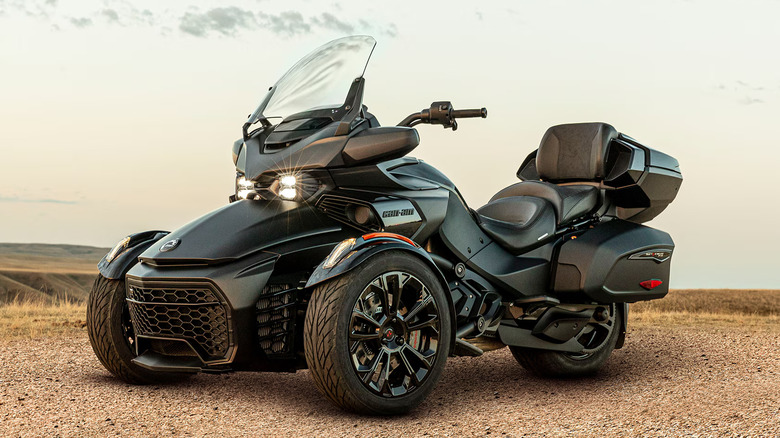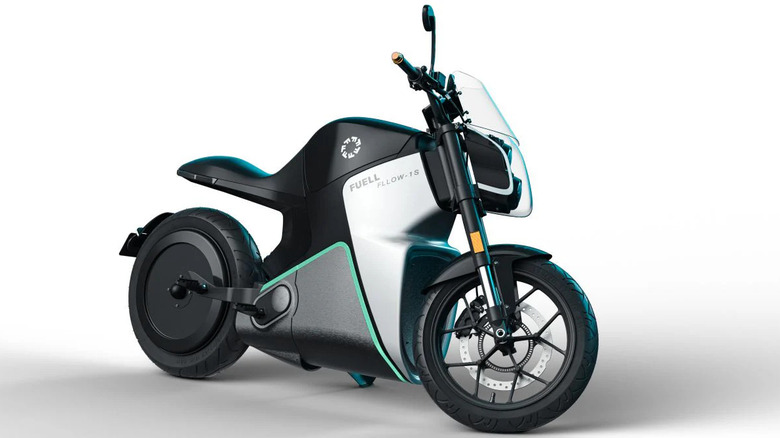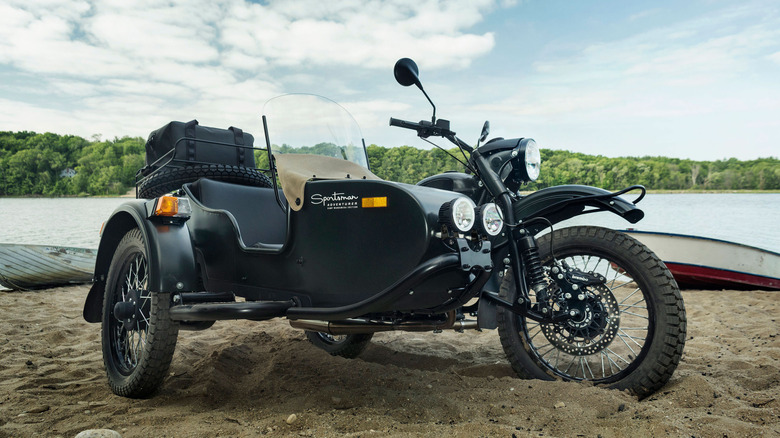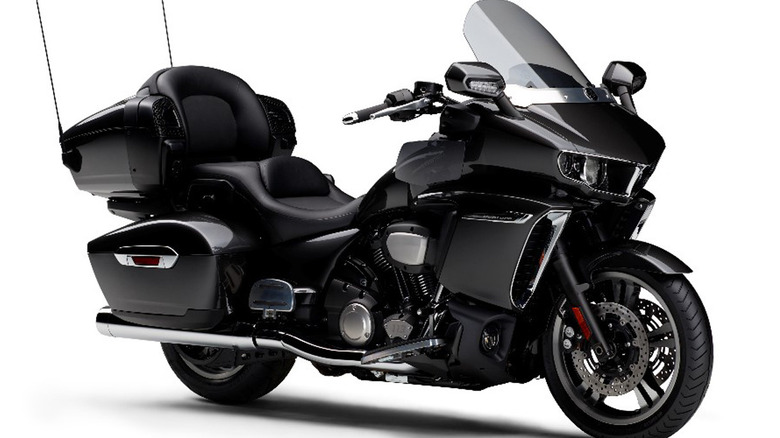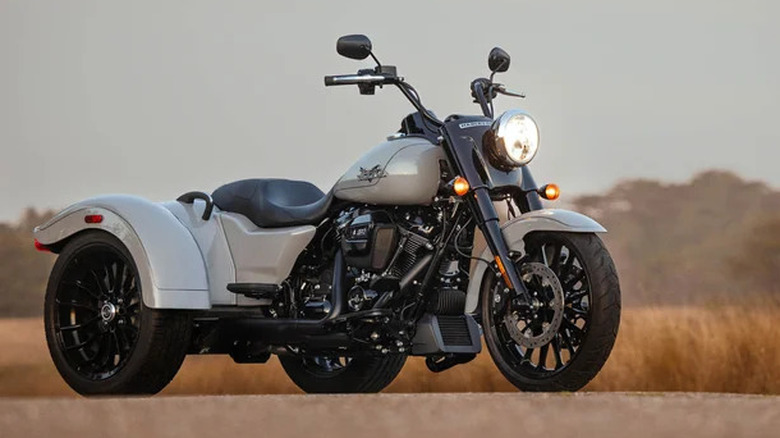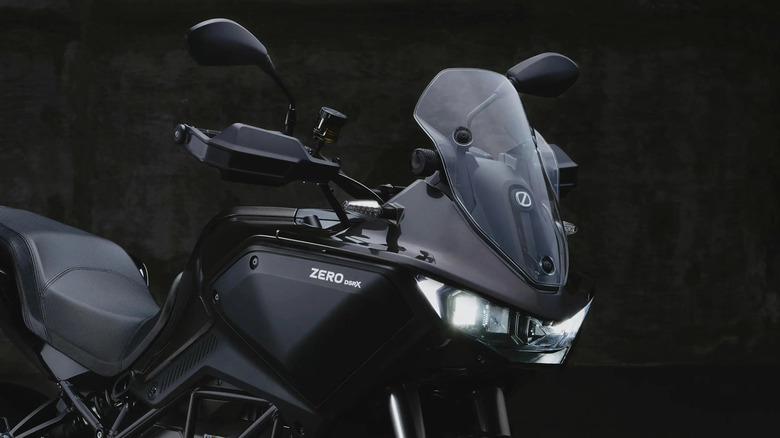9 Motorcycles Built With A Reverse Gear For Easy Backing Up
We may receive a commission on purchases made from links.
If you've ever had to walk your 600-pound motorcycle backward up an incline to navigate out of a tricky parking spot, you'll appreciate a reverse gear. Manually backing up can be a challenge in a lot of situations, especially if your motorcycle is larger and heavier than you are. Reverse gears help propel motorcycles backward, so you can worry more about steering versus keeping the bike upright. However, not every motorcycle has this feature.
Motorcycles can have various transmission types, but it's uncommon for a bike to have a reverse gear — Only a few brands are known for including them on their motorcycles. Part of the reason it isn't as widespread as many riders might hope, is that it makes the transmission more complicated, and can potentially increase the cost of a motorcycle.
If you can't live without a reverse gear — known by some manufacturers as reverse assist — here are the motorcycles you should look for. Not all of them are currently available brand new, but there might be used models still on the market. Some brands make a habit of including reverse gears on certain lines of their motorcycles, if not all of them.
BMW R 18 Transcontinental
BMW has long had a reputation for manufacturing bold and beautiful motorcycles, but the company doesn't necessarily put form over function. The BMW R 18 Transcontinental comes with optional reverse assist and other rider support features like Hill Start Control. Other R 18s also appear to offer reverse assist.
On a bike the size of the Transcontinental, any extra help is welcome. When you're on the road, the 91 hp 1,802cc engine puts in the work, but once you stop, the R18's 942-pound curb weight is all on you.
BMW states that the reverse assist function helps riders maneuver in tight spaces. Also, in a 2023 press release about the R 18 B Heavy Duty, BMW bragged that no other manufacturer includes the unique features of cruise control with distance control, reverse gear, and eCall.
According to riders online, using the R 18's reverse assist is as simple as flipping a switch to activate. You do have to hold the brake and start from neutral to activate the reverse assist function, but it doesn't require getting off the bike.
Reverse assist isn't even the best thing about the BMW R 18 Transcontinental, either. It's a great cruiser for long distance riding and can hang with the likes of the Honda Gold Wing when it comes to both rider and passenger comfort.
BMW K 1600 B Grand America
Another BMW entry with reverse assist is the K 1600 B Grand America. The reverse function is included on BMW's list of the K 1600 B's standard equipment, but the company doesn't offer much information on its website about how to use the feature.
On a 2020 K 1600, a convenient button on the left handlebar controls reverse, eliminating the manual steps that many R 18 owners have illustrated. To shift the bike back to neutral after reversing, you only have to hit the reverse button a second time. For a bike like the K 1600 B Grand America, the reverse function is invaluable. After all, it weighs 809 pounds!
Apart from the K 1600 B, BMW has some other motorcycles with reverse assist, but they're hard to pinpoint. The company doesn't exactly advertise the feature beyond a two-word mention on product pages. Some old-school BMWs also had reverse, specifically the classic R75 that was a workhorse during World War II.
Some older BMWs, such as earlier R 18s, may also have more manual reverse assist functions, but it's not clear when the motorcycle division began using reverse. It's also said that some variations of the BMW K 1600 (specifically the GT) had reverse assist as an option starting in 2016.
BMW cars, on the other hand, began utilizing a reverse assist feature — which reversed the car over its most recent however many feet traveled in drive — back in 1998.
Honda Gold Wing
Depending on your trim and chosen accessories, a Gold Wing can weigh up to about 853 pounds. Without reverse, you might be limited in parking choice, even in your own driveway.
Thankfully, widely considered one of the best Hondas ever made, the Gold Wing is packed with features and always has been. My very first motorcycle ride was as a passenger on a Honda Gold Wing, and it felt more like sitting on a chair rather than a motorcycle seat.
Given how smoothly and quietly Gold Wings tend to ride, you might hope that backing up is just as simple. Thankfully, all Gold Wings come with reverse, but your package may vary depending on whether your bike is a DCT model or has a manual transmission. DCT models also include a walking mode.
On a DCT model, Honda uses an "exclusive" low-speed reverse that runs on the engine's power. Manual transmission Gold Wings use an electric reverse, but some form of reverse is standard on every trim option. Unlike some older model BMWs, Gold Wings come equipped with various buttons to turn on reverse, but the steps are a little complicated.
The multi-step process for putting a Gold Wing into reverse involves shifting to neutral (with the front brake applied), clicking the motorcycle button, then clicking the downshift lever.
Can-Am Spyder
As the most recognizable of Can-Am's lineup, the Spyder is the easiest to point to as an example of the manufacturer's commitment to making backing up simple. In addition to having a built-in reverse gear, the Spyder also has a backup camera, so we wouldn't expect anything less than a simple process for backing up under bike power.
Not only that, but a three-wheeled bike might be near impossible to manually back up — the Can-Am Spyder F3-S, for example, is 899 pounds. Yet Can-Am doesn't limit its reverse function to its biggest and baddest bikes. Rather, the Can-Am Pulse, described as a compact bike for "zipping around town," also includes reverse. Can-Am calls the feature "very practical," which might be why the manufacturer seems to include reverse on every one of its motorcycles, whether two- or three-wheeled. Case in point? The similarly small (and electric) Can-Am Origin, intended for on- and off-road use, also has reverse built in.
On the Spyder, the reverse gear is in a bit of a strange spot, ahead of the foot pegs, but many riders find that they can use the toe of their boot to push the bike into gear. However, older Spyder models appear to have a different process for using reverse. You should, of course, follow the manufacturer recommendations for shifting into reverse.
Fuell Fllow
The Fuell Fllow is one of a handful of radical automatic bikes worth riding, and it comes with reverse assist. The Fllow is also an e-motorcycle, so it's not entirely surprising that reverse technology is part of the package. Unfortunately for prospective buyers, Fuell doesn't give much information on the reverse assist function. It only states that reverse assist exists, and notes that there is a walk mode.
Given that the Fllow's selling points are more about its electric range and modern features (Fuell says you can upgrade the e-motorcycle over time), it makes sense that the reverse gear isn't covered well in promotional materials. Instead, Fuell promotes features like blind spot detection, intelligent ABS, multiple ride modes (named "Urban" and "Audacious"), and onboard apps.
Since the Fllow is relatively new (per Fuell, shipping of the e-motorcycle begins in late 2024), only time will tell whether the reverse function is worth writing home about. Still, as far as electric motorcycles go, the Fllow might be ahead of the curve with including a reverse mode at all.
The bike is a relatively lightweight 400 pounds, too. Comparing the Fllow to other bikes with reverse gears, its size makes the reverse function even more of an upgrade versus an essential feature.
Ural Gear Up
If an electric motorcycle (or anything else super modern) isn't up your alley, there also old-school motorcycles with reverse. Ural is a unique entry into the category because it only manufactures sidecar-inclusive bikes. The Ural Gear Up is the model, with four trim options and various configurations customizable to your preference.
Ural's bikes include the Base, Standard, Sahara, and Expedition, each of which has a unique color scheme, not to mention price differences and varying feature packages. A Ural bike ranges from about $19,999 to over $26,999, but the good news is that every single model shares one common feature you're going to love.
According to Ural, all of its motorcycles come with a reverse gear standard. Each Ural bike has a 4+1 gearbox, which refers to the four forward gears and an additional reverse gear. A designated reverse gear means there are no tricky buttons to find or multi-step processes for backing up. Of course, Urals will only appeal to a specific subset of motorcyclists that are after a sidecar setup, but that's not a bad thing.
Ural also offers customization options and unique builds, so there's no limit to how you can upgrade your bike. There's also an electric Ural in the works, although the company admits it has "no immediate plans to manufacture" its electric prototype.
Yamaha Star Venture
If you're on the hunt for a Yamaha motorcycle that offers a reverse gear, we have some bad news. Currently, there doesn't appear to be a new Yamaha motorcycle on the market with a backup function. However, at least one Yamaha bike — which has since been discontinued — did have reverse.
Yamaha discontinued the impressive Star Venture after only three years, disappointing motorcyclists all over, but there are still used models out in the marketplace. Given that the Star Venture is no longer listed on Yamaha's website, it's hard to track down information on the motorcycle's reverse gear or how any of it worked.
Second-hand accounts suggest that the Yamaha Star Venture had a feature called the Sure-Park System, which included an electric motor for both forward and reverse maneuvering at low speeds.
Given how much tech the Star Venture had on board through 2021, it's not surprising that the Sure-Park functions were controlled via handlebar buttons. Beyond that, however, not much is known about Yamaha's apparently retired reverse mode function.
As for Sure-Park, that doesn't seem to exist anymore either, and it's not clear if Yamaha replaced the feature with something else. On the 2024 FJR1300ES, for example, Yamaha specifically outlines the bike's six gears (including a tall sixth gear for highway riding), but doesn't mention a reverse function or Sure-Park at all.
Harley Trikes
Like Can-Am, Harley has fully fitted its three-wheel motorcycles with every feature imaginable, including backup help. For example, the Harley-Davidson Freewheeler has electric reverse assist, and that's not uncommon on newer trikes. However, while Harley includes the feature in its list of perks, there aren't any details on how to activate the reverse mode, or exactly how it works.
Since these are modern bikes with full-color screens, you can probably expect putting your Harley-Davidson trike into reverse to be simple. Owner riders suggest that the Freewheeler and Tri-Glide have the same functionality, too. According to riders, you use the start button to put the bike into reverse once you start it up. When the bike is in reverse, an R will light up on the speedometer.
Unfortunately, Harley-Davidson doesn't seem to include reverse functionality on its bigger touring bikes, despite some of them being massive at over 800 pounds. However, there might be an aftermarket workaround — many Harley owners discuss adding reverse gears to their bikes in online forums, relying on things like aftermarket reverse gear kits.
It might be a simple DIY task for motorcyclists who are used to wrenching on their own bikes, but you might want to check with a mechanic before diving in, especially since Harley doesn't appear to endorse any aftermarket reverse function.
Zero DSR/X
Another perhaps surprising entry on the list of motorcycles with a built-in reverse gear is the Zero DSR/X. The comparatively diminutive bike (compared to trikes, that is) is the most common answer to the question of which modern motorcycles have a backup gear.
Zero doesn't explicitly call this function a reverse mode. Instead, it's a "Parking Mode," for "conquering obstacles or maneuvering in tight spaces." Whatever the manufacturer decides to call it, the gear seems to offer the same utility as other differently named reverse functions, and it's easy to use, too.
Riders can access Park Mode by choosing an option from the bike's menu, which is opened by turning on the kill switch and holding the mode button. From the menu, select Parking Mode, shut off the kill switch, and you'll be in reverse. Then, you can use the throttle to accelerate in reverse. Zero is one of the newest bikes with a reverse gear, but it seems to have its tech in order.
If none of these reverse gear-fitted motorcycles strike your fancy, there are some aftermarket options for your current ride. It's an at-your-own-risk kind of thing, but buying and installing a reverse gear kit might be a simpler fix than buying a new motorcycle.
